Hardware Components
The Hard Drive

The hard drive is where the computer stores data for long-term use. Hard drives have a hard, disk-shaped platter made of a magnetic material, and use magnets to store data on the platter. The magnetic material allows the computer to easily erase and rewrite the data whenever it needs to.
Hard drives store data as files. The data might be codes for the characters of a text file, the color of a pixel in an image file, or even a part of a song. The capacity of the hard drive is determined by how many bytes it can hold. For example, a 40 gigabyte (abbreviated GB) hard drive can hold 40 billion bytes.
Problems with hard drives can occur if they get physically damaged, overheated or wear out. Hard drive problems can also be caused by malware. You may get error messages about a hard drive failure or your computer simply gets stuck trying to access a certain file. If your hard drive is damaged, there’s very little you can do to save it. You can use data recovery tools to try and retrieve some of the data on it, but most of the time the hardware will need to be replaced.
Even if you protect your hard drive from physical damage and keep malware off your machine, your hard drive will eventually wear out, so backup your data regularly just in case. It's also a good idea to defragment your hard drive regularly to keep it running as fast as possible.
The Motherboard
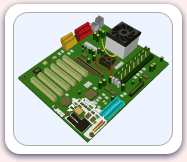
The motherboard, also called the logic board or mainboard, is a board with electrical circuits printed on it that holds many of the computer's essential components. The electrical circuits on the board allow the components to receive power and communicate with each other.
A desktop computer motherboard usually contains the CPU and the main memory, and you can attach graphics and sound cards, memory, and other peripherals to them with cards or cables. It's also very common for manufacturers to integrate some of these components directly onto the motherboard itself.
Integrated boards are usually less expensive and easier to manage since they come in a nice, tidy package. But they don’t offer the best performance, you can’t upgrade the components, and if something breaks on an integrated board, you have to replace the whole board.
The CPU
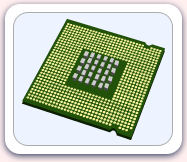
The CPU, or Central Processing Unit, is the brain of the computer. CPUs do two major things: performing mathmatical and logical operations (in other words, making the computer do stuff), and retrieving and carrying out instructions from the computer's memory.
In personal computers, the CPU is a small, square chip with many little metallic pins sticking out of it called a microprocessor, and is attached directly to the motherboard. Since they create a lot of heat, modern CPUs have a heat sink and small fan attached to keep them cool.
If something goes wrong with your CPU, it can be replaced but it's a good idea to let a professional do it. They can be expensive, and it's easy to accidentally bend the pins when trying to install it.
RAM
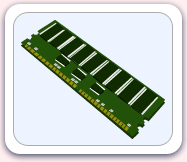
RAM, or Random Access Memory, is a type of computer memory used for short-term data storage. It is usually an integrated circuit board installed in the motherboard.
How much RAM your computer has can affect its performance. Some tasks like playing games or editing videos will use a lot more RAM than others. If it seems like your computer is taking forever to complete tasks, you may need to add more RAM. Fortunately, it's very easy to upgrade RAM. You simply install more boards or replace the ones already installed. But, before you buy any, be sure to figure out exactly how much you need and how much can fit in your computer, and get a trusted adult to help you.
The Graphics Card
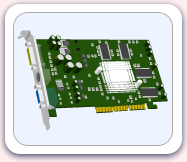
A graphics card, or video card, processes and outputs images to the computer's monitor. Less expensive graphics card are integrated directly into the motherboard, but more powerful cards come as a separate component that you can replace without having to change the entire motherboard.
The graphics card receives information from the CPU about what to display, decides how to use the pixels on the screen to display that image, and sends that information to the monitor. For 3-D images, the graphics card first creates everything out of straight lines, called a "wireframe," and then fills in all the lighting, texture and color. In a fast-paced game, it has to do this around sixty times per second.
Many people think that graphics cards are just used for playing computer games, but they are also useful for graphic designers, video editors, and 3-D animators, who usually need the best display possible.
If your graphics card is not integrated into the motherboard, it's very simple to replace. Before you buy a new one though, make sure you know what you need and what your system can support. Some monitors can't display the highest resolution that an expensive graphics card can produce, and some graphics cards use the computer's memory rather than their own to produce their display.
The Network Interface Card
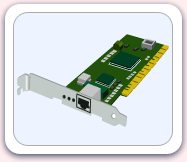
A network interface card lets you connect your computer to a network. It can be a local one, like a LAN, or the Internet if the computer connects to a modem.
The most common network interface cards are ethernet cards that use a cable to connect the computer to a network hub like a router, but there are also wireless network cards that have an antennae instead of a cable port. Many newer computers have a network card built in to the motherboard.
Each network card has a unique address that identifies the computer on the network, called a Media Access Control, or MAC, address. The address is usually assigned by the manufacturer and is part of the hardware.
The Sound Card
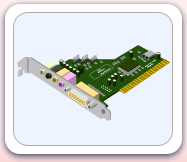
A sound card processes and plays sound files. It can work with both the internal and external speakers to provide sound. Of course, the better the sound card and speakers are, the better the sound quality.
In addition to speaker ports, a sound card will usually have a microphone port as well so you can record your own sounds.
Back